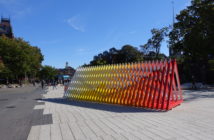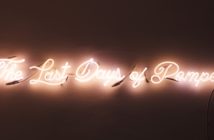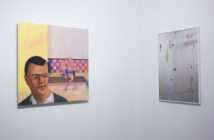West, Kathya M. Landeros’s photography show at kijidome, presents both the people and the land of Central California and Eastern Washington State, bringing a particular reality – that of Latinx agricultural communities in these regions – into focus.
In a gallery context, Landeros’s images serve as a window into a world that reveals people and land as two faces of a narrative. The selected images are at times inviting, at other times confrontational. The blend of landscapes with dreamy, cotton candy skies and portraits focused squarely on sitters commanding attention coalesce to provide a limited invitation into the everyday lives of individuals who may be lost in a greater sociopolitical narrative. As Irene Mata states in her introduction to the show, Landeros captures – to paraphrase Mata – the mundaneness of everyday life. The mundaneness of lives that do not get their due in the national narrative become grand, printed on large format.
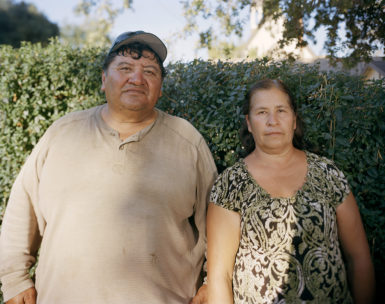
From West at kijidome. Courtesy of the artist & kijidome.
Although the people and places featured are from two different geographical locations, they are treated as a unit. The common denominator is Landeros herself. The artist’s family background - a first generation American born to Mexican parents in Northern California - and her interest in documenting the immigrant and agricultural worker experience informs the way she captures her subjects. Like other immigrant or first generation artists, her immersion into two cultures allows for a unique perspective that culls out commonalities others may miss.
Centered on a wall between two images featuring people not directly engaged with Landeros’s camera, Juan’s family, Methow Valley, Washington, starkly defies the aloof theme. The seven family members pose in what looks to be a park, their tight alignment with each other reinforcing the familial ties. It is a curious photo to serve as the lead for the show – the strong visual aspects, including the lighting and staged placement of the sitters appears only tangentially related to the other images. Perhaps, however, these are the qualities that make this portrait central to this show. Many may find the visual reinforcement of family bonds in a posed group portrait familiar. Whether or not this photo is meant to invoke memories of sitting awkwardly with your family in front of a portrait photographer, it speaks to the both the mundaneness and monumentality of family life.
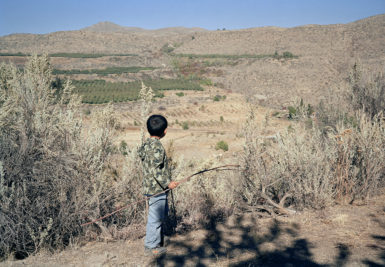
From West at kijidome. Courtesy of the artist & kijidome.
Other photographs, like Untitled (off main street), Methow Valley, Washington, and Untitled (Feather River), near Yuba City, California, show vignettes of lives that appear quiet – even when there is action happening, the image’s composition envelopes it in a tranquil panorama that is reminiscent of grand narratives of a great wide open. The essence of these photographs could be Landeros’s answer to street photography in the land of American agriculture. With the bustle of city life removed, we see individuals engaged in spaces that communicate their vastness. Untitled (off main street) is particularly reminiscent of a former gold rush town in the wild west, occupied by Latinx youth.
Tranquility extends to her portrayals of landscapes – yet, these images are punctured by small pieces of the reality. Farm worker housing, Methow Valley, Washington, a photograph as much about the dramatic sky and rolling hills as the mark of farm workers, reminds the viewer that there is a very real human cost to getting food from farm to table – even if the humans are currently absent.

From West at kijdome. Courtesy of the artist & kijidome.
Absence is something Landeros has considered before. Landeros’s life and work have made her acutely aware of the labor associated with cultivating this land. The show’s portraits, including Juan’s family, and The Hinojosas, Galt, California, work in tandem with the quiet landscapes to interject the human presence. Landeros uses conventions of portraiture, but frames sitters in what appears to be their own neighborhoods (unlike, for example, Richard Avedon’s In the American West, which presents sitters against a classic white background). We see an authentic presentation, free of glamour but full of admiration.
Untitled (Ebodio’s son), Methow Valley, Washington, unites the human and the land, depicting a young boy looking out over a valley into the distance. In what seems like a fleeting moment, he stands like a mythic explorer surveying new territory – a playful reimagining of the exclusionary narrative of Manifest Destiny. The world he builds for himself is crafted from his experiences living in this particular region, a product of this unique cultural background.

From West at kijidome. Courtesy of the artist and kijidome.
What Landeros asserts, and the layout in kijidome reinforces, is you cannot assume to know the landscape of the West without acknowledging the people who labor in and live on the land. The exhibition oscillates between intimate glimpses into these lives and reserved reflections on the land. Landeros simultaneously lets us marvel at the picturesque qualities of the land and the people who live within it.
West runs through April 23.


